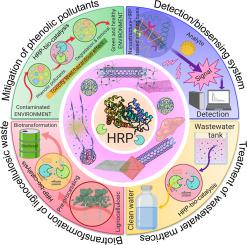Science of the Total Environment ( IF 9.8 ) Pub Date : 2020-09-15 , DOI: 10.1016/j.scitotenv.2020.142360 Muhammad Bilal , Damiá Barceló , Hafiz M.N. Iqbal

|
High catalytic efficiency, stereoselectivity, and sustainability outcomes of enzymes entice chemists for considering biocatalytic transformations to supplant conventional synthetic routes. As a green and versatile enzyme, horseradish peroxidase (HRP)–based enzymatic catalysis has been widely employed in a range of biological and chemical transformation processes. Nevertheless, like many other enzymes, HRP is likely to denature or destabilize in harsh realistic conditions due to its intrinsic fragile nature, which results in inevitably shortened lifespan and immensely high bioprocess cost. Enzyme immobilization has proven as a prospective strategy for improving their biocatalytic performance in continuous industrial processes. Nanostructured materials with huge accessible surface area, abundant porous structures, exceptional functionalities, and high chemical and mechanical stability have recently garnered intriguing research interests as novel kinds of supporting matrices for HRP immobilization. Many reported immobilized biocatalytic systems have demonstrated high catalytic performances than that to the free form of enzymes, such as enhanced enzyme efficiency, selectivity, stability, and repeatability due to the protective microenvironments provided by nanostructures. This review delineates an updated overview of HRP immobilization using an array of nanostructured materials. Furthermore, the general physicochemical aspects, improved catalytic attributes, and the robust practical implementations of engineered HRP-based catalytic cues are also discussed with suitable examples. To end, concluding remarks, challenges, and worthy suggestions/perspectives for future enzyme immobilization are also given.
中文翻译:

纳米结构材料,可利用辣根过氧化物酶的能力来满足特定的环境应用
酶的高催化效率,立体选择性和可持续性结果诱使化学家考虑采用生物催化转化来替代常规合成路线。作为一种绿色且用途广泛的酶,基于辣根过氧化物酶(HRP)的酶催化已广泛应用于一系列生物和化学转化过程。然而,像许多其他酶一样,HRP由于其固有的易碎特性,可能在苛刻的实际条件下变性或不稳定,这不可避免地缩短了寿命,并极大地提高了生物工艺成本。固定化酶已被证明是在连续工业过程中提高其生物催化性能的前瞻性策略。具有巨大的可触及表面积,丰富的多孔结构,出色的功能性的纳米结构材料,高化学稳定性和高机械稳定性最近引起了人们的兴趣,作为HRP固定化的新型支撑基质。许多报道的固定化生物催化系统已显示出比游离形式的酶更高的催化性能,例如由于纳米结构提供的保护性微环境,提高了酶的效率,选择性,稳定性和可重复性。这篇综述描述了使用一系列纳米结构材料对HRP固定化的更新概述。此外,还通过适当的示例讨论了一般物理化学方面,改进的催化特性以及工程化的基于HRP的催化线索的可靠实用实现。最后,总结,挑战,



























 京公网安备 11010802027423号
京公网安备 11010802027423号